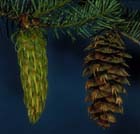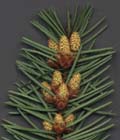
The Queets fir, for 50 years one of the largest known Douglas-firs [C.J. Earle].

Immature and mature cones [Dr. Linda B. Brubaker].

Closeup of the underside of a sun foliage shoot of P. menziesii , showing pollen cone buds and the manner of leaf attachment to the twig [C.J. Earle].

Active pollen cones on a shoot of var. menziesii [C.J. Earle].
Common Names
Douglas-fir; Douglas, yellow or red spruce; Oregon pine, Douglastree (3), sapin de Douglas (French) (4); red-fir, piņo Oregon (Spanish) (5).
Taxonomic notes
Syn: Abies menziesii Mirbel 1825; A. mucronata Rafinesque; A. taxifolia Poiret 1805, not Desfontaines 1804; Pinus taxifolia Lambert 1803, not Salisbury 1796; Pseudotsuga douglasii (Lindley) Carričre; P. mucronata (Rafinesque) Sudworth; P. taxifolia (Lambert) Britton (4).Two intergrading varieties, menziesii and glauca , sympatric in southern BC and northeastern WA (4).
Description
"Trees to 90(100) m; trunk to 4.4 m diam.; crown narrow to broadly conic, flattened in age. Twigs slender, pubescent, becoming glabrous with age. Leaves 15-30(-40) × 1-1.5mm, yellow-green to dark or bluish green, apex obtuse to acute. Pollen cones yellow-red. Seed cones 4-10 × 3-3.5 cm. Seeds 5-6 mm, wing longer than seed body" (4). Detailed information on pollen, including photomicrography, can be found at (6).Range
W US & Can, N Mexico (1). The "native range, extending from latitude 19° to 55° N., resembles an inverted V with uneven sides. From the apex in central British Columbia, the shorter arm extends south along the Pacific Coast ranges for about 2200 km (1,367 mi.) to latitude 34° 44', representing the range of the typical coastal or green variety, menziesii; the longer arm stretches along the Rocky Mountains into the mountains of central Mexico over a distance of nearly 4500 km (2,796 mi.), comprising the range of the other recognized variety, glauca - Rocky Mountain or blue. ... Altitudinal distribution of both varieties of Douglas-fir (menziesii and glauca) increases from north to south, reflecting the effect of climate on distribution of the species. The principal limiting factors are temperature in the north of the range and moisture in the south. Consequently, Douglas-fir is found mainly on southerly slopes in the northern part of its range, and on northerly exposures in the southern part. At high elevations in the southern Rocky Mountains, however, Douglas-fir grows on the sunny slopes and dry rock exposures (Silen 1978)" (5).Big Tree
See var. menziesii. This is the largest member of the Pinaceae (the second largest, Picea sitchensis, grows with P. menziesii in the coastal forests of NW North America) and larger by far than the other species in the genus.Oldest
See var. menziesii.Dendrochronology
Many chronologies representing both varieties exist. The species has been used extensively in climate reconstruction and archeological dating. It has also been employed in ecological studies and stable isotope work.Ethnobotany
Pseudotsuga menziesii is one of the world's most important timber trees, valued in both the Old and New worlds (4, 5). It has been widely planted in New Zealand and is there regarded as an invasive weed.Observations
Easily seen in the western USA and Canada. See vars. menziesii and glauca for details.Remarks
One of the most-studied conifers in the world."Douglas-fir ... has been a major component of the forests of western North America since the mid-Pleistocene (Hermann 1985). Although the fossil record indicates that the native range of Douglas-fir has never extended beyond western North America, the species has been successfully introduced in the last 100 years into many regions of the temperate forest zone (Hermann 1987)" (5).
Douglas-fir is the state tree of Oregon (4).
Citations
(1) Silba 1986.(2) Elias 1987.
(3) Peattie 1950 (as P. taxifolia).
(4) Lipscomb, Barney at the Flora of North America web site.
(5) R.K. Hermann and D.P. Lavender, p. 527-540 in Burns & Honkala 1990.
(6) Owen K. Davis. 1999. Pollen Grain Morphology Hemlock. URL=http://geo.arizona.edu/palynology/pid00013.html, accessed 6-Feb-2000.
See also:
Pseudotsuga | Pinaceae | home
This page is from the Gymnosperm Database
URL: http://www.geocities.com/~earlecj/pi/ps/menziesii.htm
Edited by Christopher J. Earle
E-mail:
earlecj@earthlink.com
Last modified on 6-Feb-2000